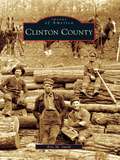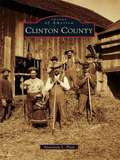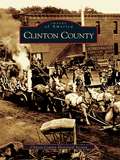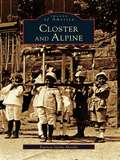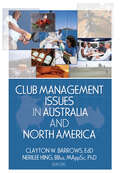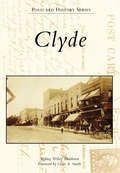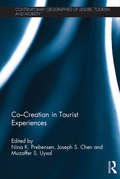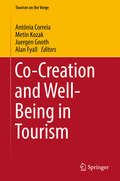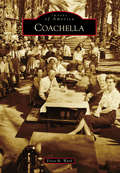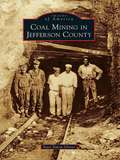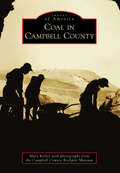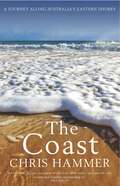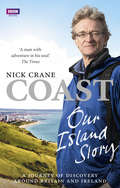- Table View
- List View
Clinton
by Chad ChisholmClinton, Mississippi, is the home of Mississippi College, the state's oldest existing institution of higher learning. Clinton produced statesmen such as Walter Leake, writers and artists such as Barry Hannah and Wyatt Waters, and modern celebrities such as Lance Bass and Mandy Ashford. Today Clinton serves as a bedroom community for Jackson. Clinton began as the Mount Dexter trading post on the Old Natchez Trace. The town was founded as Mount Salus in 1823 by Walter Leake, one of Mississippi's first U.S. senators and the third governor. Six years later, Clinton fell one vote short of becoming the state capital. Through antebellum prosperity, occupation by Union troops, rebirth as a college community, and growth into a postwar suburban center, Clinton and its people have been marked by independence. This pictorial history is a chronicle of Clinton's most indelible individuals, families, and institutions.
Clinton County
by Eric M. SmithClinton County was originally inhabited by the Shawnee, Lenape, and Iroquois tribes. Lumber was abundant, and it drew in settlers searching for a home and work. A diversity of industry developed as people settled in the area, from brickwork in Farrandsville and Mill Hall to the heyday of the Piper Cub and Piper Aviation. During 1889, 1918, 1936, and 1972, floods tore through the county beforea levee system was finally constructed in Lock Haven in the 1990s. Education has been an important mainstay in the area, and one-room schoolhouses once dotted the landscape. The Central State Normal School, now Lock Haven University, was a regional draw for those seeking a career in teaching. Through historic photographs, Clinton County illustrates the changes that have occurred in this area over the years and traces the history of the people who created this heartland Pennsylvania community.
Clinton County (Images of America)
by Anastasia L. PrattFirst permanently settled after Samuel de Champlain's voyages through the region and officially chartered in 1788, Clinton County offers a host of agricultural and industrial pursuits. With a rich military history, the county was pivotal in the American Revolution as the birthplace of the U.S. Navy. Life in the county has been greatly enhanced by strong family traditions, religious celebrations, and social justice movements like the Underground Railroad. Clinton County is home to the city of Plattsburgh, the towns of Altona, Au Sable, Beekmantown, Black Brook, Champlain, Chazy, Clinton, Dannemora, Ellenburg, Mooers, Peru, Plattsburgh, Saranac, and Schuyler Falls, and the villages of Champlain, Dannemora, Keeseville, and Rouses Point.
Clinton County (Images of America)
by Clinton County Historical SocietyBefore settlers first arrived in the 1800s, Clinton County rested full of promise along the western edge of the Mississippi River. In the years that have passed, it has become an area of great commercial, agricultural, and industrial accomplishments. From the initial settlement of Lyons, DeWitt, and Camanche, where axe and oxen were prevalent on the scene, to the modern communities that are now home to astronauts and artisans, this book illustrates the incredible growth that has occurred over nearly two centuries. Through over 200 historical photographs, the Clinton County Historical Society documents how Clinton County has become a national treasure of culture and character.
Clinton, Flemington, and Lambertville (Images of America)
by Sally A. FreedmanLife among the rolling hills of northwest New Jersey and in the three small towns that became centers of that area's population has been faithfully recorded by residents since the Civil War, capturing the rural character of their landscape. The rich heritage of descendants of English, Dutch, and German settlers in the Hunderton County population centers of Clinton, Flemington, and Lambertville is presented here.
Clinton, Iowa (Images of America)
by Clinton County Historical SocietySince settlers first touched upon its shores in 1835, the city of Clinton, Iowa has evolved from a humble trading post on the Mississippi River into a vibrant city of thriving commerce, majestic homes, and riverfront splendor. Once the largest lumber milling center in the world, Clinton has long possessed a rich cultural heritage and a pioneering spirit. This book documents and explores the history of this proud community through a unique collection of historical photographs.
Clinton: 1940-1980 (Images of America)
by Chad ChisholmIn 1940, the town of Clinton had scarcely grown in size or population since the Civil War. However, the coming of World War II forever changed the identity of this small Southern college town. Aside from the sudden departure of its best and brightest men and women for the front lines, global war touched Clinton in the form of a German POW camp and a Navy V12 training school at Mississippi College. Clinton: 1940-1980 picks up where author Chad Chisholm ended his previous book, with Clinton in the midst of postwar growth. It is a chronicle of Clinton's living history, a treasury of photographs for all Clintonians.
Closter and Alpine
by Patricia Garbe-MorilloCloster and Alpine are situated on the slopes of the Palisades cliffs, tucked into the northeastern corner of New Jersey. Rising some five hundred feet above the Hudson River, the peaks of these cliffs offer some of the most spectacular scenery in the state. On these slopes the earliest pre-Revolutionary settlements were established and nineteenth- and twentieth-century mansions were built. Closter and Alpine includes the region's earliest history, beginning with "Wooly," the ten-thousand-year-old long-haired mastodon discovered in 1974. The 1776 British invasion led by Lord Cornwallis and the cruel murder of ninety-year-old Douwe Tallman were early local events of the Revolutionary War. During the nineteenth century, the freed slave community of Skunk Hollow was founded, a community to which present Closter residents can trace roots. One of the most unique parts of the history of Closter and Alpine are the "Houses like Fords," the "assembly-line" homes built by the Lustron Corporation during the post-World War II housing shortage. Closter and Alpine have the only two of these houses remaining in Bergen County.
Clotilde's Edible Adventures in Paris
by Clotilde DusoulierClotilde Dusoulier, a native Parisian and passionate explorer of the city’s food scene, has won a tremendous following online with her insider reports and wonderful recipes on her blog, www. chocolateandzucchini. com. Her book,Chocolate and Zucchini, introduced her to a wider, equally enthusiastic audience. Now inClotilde’sEdible Adventures in Paris,Clotilde reveals her all-time favorite food experiences in her native city. She takes us on a mouthwatering tour of the restaurants, markets, and shops she loves the most: from the best places to go for lunch, tea, or a glass of wine, to “neo bistros” and the newest places to find spectacular yet affordable meals. Packed with advice on everything from deciphering a French menu to ordering coffee correctly, this book is like having Clotilde as a personal guide. A dozen tempting recipes are also included, shared or inspired by Clotilde’s favorite chefs and bakers. For first-time visitors and seasoned travelers alike,Clotilde’sEdible Adventures in Parisoffers invaluable insider recommendations on eating and shopping with Parisian panache. The best of Paris, featuring 164 restaurants, bistros, wine bars, andsalons de thé, as well as over 130 bakeries, pastry shops, cheese shops, bookstores, chocolate and candy shops, cookware and tableware stores, specialty shops, outdoor markets, and much, much more!
Cloud Forest: A Chronicle of the South American Wilderness
by Peter MatthiessenPeter Matthiessen crisscrossed 10,000 miles of the South American wilderness, from the Amazon rain forests to Machu Picchu, high in the Andes, down to Tierra del Fuego and back. He followed the trails of old explorers, encountered river bandits, wild tribesmen, and the evidence of ancient ruins, and discovered fossils in the depths of the Peruvian jungle. The Cloud Forest is his incisive, wry report of his expedition into this vast world to the south.
Cloverdale
by Joan Wagele Cloverdale Historical Society Marge GrayCloverdale lies nestled among forested hills and colorful vineyards at the north end of Sonoma County's famed Alexander Valley. Originally inhabited by the Makahmo Pomo with white settlers beginning to arrive in the 1850s, the town later became known as "The Orange City" because of its flourishing groves of citrus. In the latter years of the 19th century, Cloverdale welcomed trainloads of visitors arriving to enjoy its signature event, the annual Citrus Fair, to relax at Russian River resorts or to experience the geothermal wonders of The Geysers. During the same period, unique communities developed outside of town--a religious colony around a charismatic healer, a utopian community of French socialists, and an agricultural settlement of Italian immigrants that became the unparalleled Italian Swiss Colony winemaking enterprise. Over the years, Cloverdale has been a farm town, a regional transportation hub, a stopping point for Redwood Highway travelers, and a thriving lumber town. More recently, Cloverdale has been refashioning itself into a distinctive tourist destination while retaining its identity as a friendly hometown.
Club Management Issues in Australia and North America
by Clayton W. Barrows Nerilee HingDiscover the unique challenges confronting the club industryAs a distinctive sector of the hospitality industry, private clubs have their own unique set of challenges. Club Management Issues in Australia and North America provides a one-of-a-kind exploration of the membership, human resource, and other key management issues of the niche industry of private clubs-on two very different continents. This book closely examines the latest research to provide scholars and practitioners with a clear picture of the economic and social implications springing from the growth of the diverse private club industry while offering cogent discussions on effective management strategies.The impact of economic downturns affects all sectors of the hospitality market, including the private club industry. Club Management Issues in Australia and North America illustrates the trends now seen in the club industry in two major world markets. The book examines the declining membership issues in the United States and presents thoughtful consideration of member recruitment strategies. Australia&’s marked differences in private clubs are comprehensively explained, with a clear focus on the gaming aspect present there. An overview of the history of the club industry in Australia is presented, with emphasis on gaming machine operations and the positive and negative social and economic impact gambling has on the country. A thematic review of club management issues from years past gives readers a clearer understanding of where the industry is today and what areas need more empirical research. Employment relations are discussed in detail. A comparative analysis is also presented of the various challenges faced by clubs competing with one another. Legislative restrictions of advertising and marketing are explored, along with crucial membership and patronage issues.The book provides: research on changes in memberships in clubs in the United States a study on declining waiting lists at clubs characteristics club managers look for in job applicants differences in equity and non-equity membership structures an overview of the history of machine gambling in New South Wales analyses of past issues of taxation legislation, employment relations, social issues, innovation, and others-and the need for further empirical study how regulatory changes impact wage determination the effects of legislation restrictions on gaming advertising, promotion, and external signage analysis of the impact of clubs&’ involvement with special events consumer behavior in the club industry a case study of a club&’s failed attempt to tap into the youth marketClub Management Issues in Australia and North America is timely, informative reading for hospitality educators and students, hospitality professionals, and hospitality companies doing research in the private club industry.
Clueless in Tokyo
by Betty ReynoldsA perfect introduction to Japan and Japanese culture, this edition contains many new illustrations as well as the Japanese script for key words and phrases. Adult students and travelers alike will embrace Clueless in Tokyo as a charming and insightful souvenir to be treasured. Some people take photos, but artist Betty Reynolds captures memories with her paintbrush and watercolors. Clueless in Tokyo provides an outsider's take on everyday life in Japan's capital city--a place where vending machines talk, toilets can be terrifying, and centuries-old festivals unfold against a backdrop of space-age architecture. During the seven years Reynolds lived in Japan, she filled thirty sketchbooks with everything that caught her eye. Whether it's fashion, food, sport, transport, seasonal rituals, or Japanese pastimes, each vibrant sketch is a delight, and Reynolds' witty hand-lettered captions in both Japanese and English provide an entertaining resource for beginning learners of Japanese.
Clyde (Postcard History Series)
by Gene A. Smith Tiffany Willey MiddletonClyde is a community located in northwest Ohio, less than one hour southeast of Toledo, with a population of approximately 6,500 people. In many ways, Clyde is a famous small town�it has been launched into the national spotlight numerous times during its 150-year history. Clyde was the home of Civil War hero James B. McPherson, political cartoonist James Albert Wales, author Sherwood Anderson, and World War II hero Rodger Young. The images in this volume provide windows into Clyde�s storied history and offer glimpses of the everyday moments shared by its citizens.
Co - Creation in Tourist Experiences (Contemporary Geographies of Leisure, Tourism and Mobility)
by Nina K Prebensen Joseph S Chen Muzaffer S UysalThe tourist experience is multi-faceted and dynamic, as tourists engage with its formation and creation. The tourists then become vital in creating value for themselves together with the service provider. Experience value cannot be pre-produced, but is co-created between host and guest(s) in the servicescape. The tourist managers can therefore only plan for and facilitate for value co-creation to take place. This book responds to the need for a critical review of how firms can facilitate and dramatize for enhanced experience value for tourists. As the roles of participants and providers are changing rapidly, new knowledge in terms of how value creation and value co-creation can transpire needs to be generated. The aim of this book is therefore to accentuate the role and importance of the core elements in value creation processes, namely, the customer(s), the setting in which co-creation would take place, and the provider. Bringing together scholars from diverse areas to address the nature of how the actors co-create values through interaction in different experience settings, the book also serves as a guide to the best practice of co-creation of tourist experiences. It will therefore appeal practically as well as theoretically to scholars and students of tourism, marketing, leisure, hospitality, and services management.
Co-Creating Tourism Research: Towards Collaborative Ways of Knowing (Contemporary Geographies of Leisure, Tourism and Mobility)
by Carina Ren Gunnar Thór Jóhannesson René Van Der DuimCo-creation has become a buzzword in many social science disciplines, in business and in tourism studies. Given the prominence of co-creation, surprisingly little discussion has evolved around its implications for research practices and knowledge production as well as what challenges there are for fulfilling the promise of co-creation in tourism research. This book aims to contribute to this discussion by addressing how tourism research comes together as a collaborative achievement and by exploring different ways of collaborative knowledge production in tourism research. It is structured to offer, on one hand, an introduction to the ontological basis for collaborative research and, on the other hand, a set of empirical examples of how collaborative knowledge creation can inform tourism design, management, policy and education. The theoretical accounts and empirical cases of this book display how research collaborations can offer modest, local yet often impactful insights, traces and effects. It therefore will be of value for students, researchers and academics in tourism studies as well as the wider social sciences.
Co-Creation and Well-Being in Tourism (Tourism on the Verge)
by Alan Fyall Metin Kozak Antónia Correia Juergen GnothThis book offers a wealth of new views and interpretations of well-being in tourism, emphasizing the role that co-creation - the creation or enhancement of value through tourist engagement with tourism providers and other tourists - is increasingly playing in enriching tourist experiences. A combination of theoretical and empirically based contributions relating to various tourism contexts shed light on existing and potential contributions of tourists and destination providers to tourist well-being. Readers will find novel and compelling insights into both the very nature of wellbeing as perceived by the tourist and the opportunities that are emerging as tourists become savvy decision-makers capable of activating their own networks and resources in order to shape their experiences. The book will be of interest for all who wish to learn more about the character and the construction of well-being within tourism, the relationship of well-being to a range of factors, and the ways in which tourism operators can assist tourists in creating high-value experiences.
Coachella (Images of America)
by Erica M. WardCoachella was founded by Jason L. Rector in 1884 under the name of Woodspur. Rector established a wood siding for the railroad company and cleared the mesquite trees in the local area. As the town developed with the guidance and hard work of the early residents, the town elected to change its name to Conchilla in 1901. However, a clerical error would result in the town's name being registered as Coachella. The growth and development of the town would steadily continue while the agricultural industry took advantage of the year-round growing season. The unique development of the date industry in Coachella and the surrounding towns provided a strong economy for local residents. Flourishing in the unforgiving extreme heat of the Coachella Valley remains a testament to the ingenuity of the people of this desert valley.
Coal Mining in Jefferson County
by Staci Simon GloverUniquely, Jefferson County had all of the elements necessary for the fabrication of iron and steel within its borders. Coal, limestone, and iron ore all lay within close proximity to Birmingham. The right amounts of business acumen, industrial planning, and labor force came together creating the industry that made Birmingham the "Magic City." The coal mining towns in the Birmingham Industrial District have rich histories--a Hollywood movie was made in one, a novel was written about another, and a soccer championship was won in yet another town. These coal towns and the miners who lived in them are as responsible as anyone for the birth of Birmingham industry.
Coal in Campbell County (Images of America)
by Mary Kelley Campbell County Rockpile MuseumIn his Annual Report of the Territorial Geologist to the Governor of Wyoming 1890, Louis D. Ricketts wrote, "The coal of this district has little other use than that of supplying a local market." Years later, nothing could be further from the truth. The United States uses approximately one billion tons of coal a year, with about 390 million tons coming from Campbell County, Wyoming. Since large-scale commercial coal production began in Campbell County in the mid-1970s, most coal companies have changed names, owners, and boundaries several times. To let those changes go unrecorded would be to lose the very beginning of coal in Campbell County.
Coast to Coast: A Journey Across 1950s America
by Jan MorrisA first book by the author of "Fifty Years of Europe" finds its writer, living a very different identity and having recently reported on the first Everest ascent in 1953, traveling by various means across the United States and witnessing first hand the country's optimism and comparative innocence.
Coast: A Journey Along Australia's Eastern Shores
by Chris HammerFrom the winner of the ACT Book of the year Award for his first book, The River, comes this celebration of the Australian seascape, from its natural grandeur to the quirky individualism of those who live beside it. It is also the heartfelt and pertinent story of the issues facing our coast today and the resilience of communities at a turning point. Chris Hammer travels the length of the east coast of Australia on a journey of discovery and reflection, from the Torres Strait to Tasmania; from an island whose beach has been lost forever to the humbling optimism of the survivors of Cyclone yasi; from the showy beaches of Sydney to a beautiful village that endures despite the loss of its fishing fleet. This is a relevant, satisfying and highly readable book, imbued with a sense of optimism and humour. Even as new economic imperatives emerge and the shift in our climate becomes apparent, we can revel in the heritage and character of our shores, reminding us why the coast is so important to all of us.
Coast: A Journey of Discovery Around Britain's Coastline
by Nicholas CraneAlong our shores, towering cliffs from the age of the dinosaurs rise beside wide estuaries teeming with wildlife, while Victorian ports share waterfronts with imposing fortifications.And the people who have lived, worked and played on this spectacular coast - from Stone Age fishermen to seafarers, chart-makers and surfers - have an incredible tale to tell.Coast: Our Island Story is an enthralling account, sparkling with geography, history, adventure and eccentric characters, told with Nick Crane's trademark charisma and wit.
Coastal Architectures and Politics of Tourism: Leisurescapes in the Global Sunbelt
by Sibel BozdoǧanThis volume offers a critical and complicated picture of how leisure tourism connected the world after the World War II, transforming coastal lands, traditional societies, and national economies in new ways. The 21 chapters in this book analyze selected case studies of architectures and landscapes around the world, contextualizing them within economic geographies of national development, the geopolitics of the Cold War, the legacies of colonialism, and the international dynamics of decolonization. Postwar leisure tourism evokes a rich array of architectural spaces and altered coastal landscapes, which is explored in this collection through discussions of tourism developments in the Mediterranean littoral, such as Greece, Turkey, and southern France, as well as compelling analyses of Soviet bloc seaside resorts along the Black Sea and Baltic coasts, and in beachscapes and tourism architectures of western and eastern hemispheres, from Southern California to Sri Lanka, South Korea, and Egypt. This collection makes a compelling argument that "leisurescapes," far from being supra-ideological and apolitical spatial expressions of modernization, development, and progress, have often concealed histories of conflict, violence, social inequalities, and environmental degradation. It will be of interest to architectural and urban historians, architects and planners, as well as urban geographers, economic and environmental historians.
Coastal Architectures and Politics of Tourism: Leisurescapes in the Global Sunbelt
by Sibel BozdoǧanThis volume offers a critical and complicated picture of how leisure tourism connected the world after the World War II, transforming coastal lands, traditional societies, and national economies in new ways.The 21 chapters in this book analyze selected case studies of architectures and landscapes around the world, contextualizing them within economic geographies of national development, the geopolitics of the Cold War, the legacies of colonialism, and the international dynamics of decolonization. Postwar leisure tourism evokes a rich array of architectural spaces and altered coastal landscapes, which is explored in this collection through discussions of tourism developments in the Mediterranean littoral, such as Greece, Turkey, and southern France, as well as compelling analyses of Soviet bloc seaside resorts along the Black Sea and Baltic coasts, and in beachscapes and tourism architectures of western and eastern hemispheres, from Southern California to Sri Lanka, South Korea, and Egypt. This collection makes a compelling argument that "leisurescapes," far from being supra-ideological and apolitical spatial expressions of modernization, development, and progress, have often concealed histories of conflict, violence, social inequalities, and environmental degradation. It will be of interest to architectural and urban historians, architects and planners, as well as urban geographers, economic and environmental historians.

